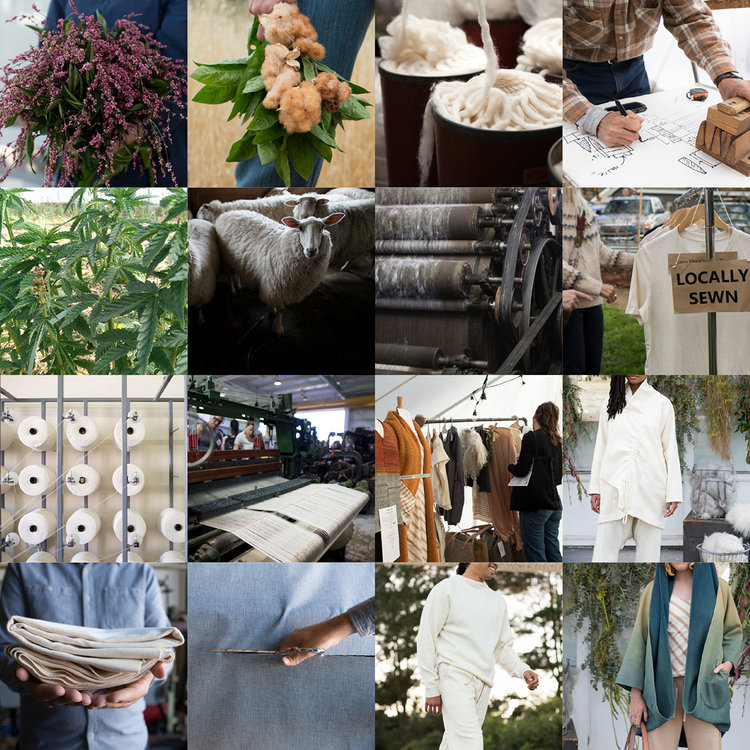STRATEGIC CONSULTING CLIENTS
Designing the Future
PATHWAYS THROUGH FIBERSHEDS TO NATURAL RESOURCE MANAGEMENT,REGIONAL ECONOMIC DEVELOPMENT, AND BRIDGING CULTURAL DIVIDES
BY NIKKI SILVESTRI, REBECCA BURGESS & BETH RAPS, WITH OSAYI ENDOLYN
DOWNLOAD THE FULL REPORT: DESIGNING-THE-FUTURE
(EXCERPT BELOW)
EXECUTIVE SUMMARY
Designing the Future shows that investment in place-based textiles (“fibersheds”) regenerate economies, ecologies, and human relationships. Investment in fibersheds—as an exemplar for other economic development strategies—empowers real change in three areas simultaneously: labor and regional economic development; environmental repair, especially climate restoration; and healing across human divides.
You may ask: what capacity do we have within the US to meet consumer demand for clothing? “Designing the Future” shows that all our clothing could be soil-to-soil produced within the United States using wool alone—to say nothing of cotton, flax, and other sources of natural fiber touched on in the paper.
The paper’s point is not that “anything is possible.” Our point is that much more is possible than we realize. Economic development of the past has encouraged our consumer appetite for cheap, low-quality goods by veiling the ecological and social cost of creating such goods. Investments in regional production chains like fibersheds support people creating jobs for their communities, rebuilds a market for regionally produced items, and provide decent livelihoods.
One key is removing barriers that privilege large-scale production and work against smallholders. Lest we think “small” means insignificant, the United Nations Food and Agricultural Organization reminds us that 80% of the world’s agriculture is produced by smallholders.
The Bureau of Labor Statistics describes the fashion economy in a way that makes it clear it is ripe for change in just these ways: “The industry is characterized by short product life cycles, erratic consumer demand, an abundance of product variety, and complex supply chains.” It thus becomes not so much visionary as obvious that investing in fibersheds makes sound economic sense.
As we show in the paper, we don’t have a jobs or a production problem—we have a design problem and a mindset problem. Here are the components to the solution explored in this paper:
- Updated, cutting-edge education
- Revised narratives about blue-collar jobs and the importance of work that clothes us
- New technologies integrated with craft
- Focusing on genuine regionally driven, regionally planned and invested-in economic development
- Harvesting the solutions that come when we refuse to pit environment against economics.
Economic interests are often positioned oppositionally to environmental ones, so the first half of the paper addresses those directly. Part I finds that integrative economic development is environmentalism. Part II shows that environmentalism is also economic development.
All Earthly economics start in soil. Meeting basic human needs through a soil-centered approach roots economic sustainability right into the solution. Environmental health can be a creative, lucrative guiding principle for fibershed businesses all the way from “sheep to shawl.” This is a “multi-system wide” approach that uses ecosystem management to care for a landscape, create jobs and make a profit.
If communities keep their production processes regional, they not only build wealth, but demonstrate that there is long-term value in preserving land by working it. We learn many useful lessons as investors in fibersheds from the sustainable food movement. In particular, the economic development of regional fibersheds as natural resource management does not close off but opens doorways for new ideas, allies, and investment to increase the pace of change. For one provocative example, we could sequester (more than) all our CO2 emissions if we switch to practices of regenerative organic agriculture.
Thinking regionally helps ensure that climate resiliency has economic strategies that actually work by linking structurally to regional supply chains and deeply better regional livelihoods.
In Part III, we start from the premise that all people want to be acknowledged, and see real opportunities for futures they genuinely desire. We can invest in people who want to make things for a living with dignity and pride to enable them and us to cultivate the lifestyles we imagine. When we think multi-system-wide about ways to create blue-collar jobs and job training, especially for vulnerable populations, we see that we must take as much care designing power, ecology, and regenerated relationship into these structures as are included in the design of white-collar jobs and job “training.” Economic divides and racialized policy will greatly impact the accessibility of that future for all. And whether or not we are working directly on rural issues, we must understand them.
In Part III, we show that fibersheds regenerate relationships, of:
- producers to each other
- producers to soil
- producers to businesses that give them sustained livelihood
- producers to consumers
- consumers to soil
- consumers to sustainable jobs and businesses
- businesses to their workers, customers and soil.
The people profiled and interviewed in this paper are thinking about how to benefit people and ecosystems far beyond their regions. If we observe the examples and listen to these visionary farmers, writers, nonprofit and for-profit entrepreneurs, what’s not just possible but already being done is inspiring. It obviously deserves our support.
What are the most strategic ways to direct that support? Our Conclusion touches on several we have thought of. We invite you to add your own, and tell us about them.
Everything we point to as possible in this paper already exists. Those who are able to support this new future now will make it possible for many more to do so in the near future—not only as investors but as consumers, producers, promoters.
Suggested citation for this publication: Silvestri, Nikki, Rebecca Burgess and Beth Raps, with Osayi Endolyn, “Designing the Future, Executive Summary.” San Geronimo, CA: Fibershed, in partnership with Soil and Shadow.
LEARN MORE
Ellen Macarthur Foundation's 2017 Circular Economy Summit [see recorded presentation here]
KCET's SoCal Connected Segment on Environmental Justice
Youth Passageway's Confluence Journal - Resist. Insist. Love.
Delicious Revolution Podcast - Carbon Farming & The Need For Economic Power In the Food Movement
Reinvent's The Future of Sharing Series - Ecology, Economy & Equity: Taking a Holistic View of Sustainability

